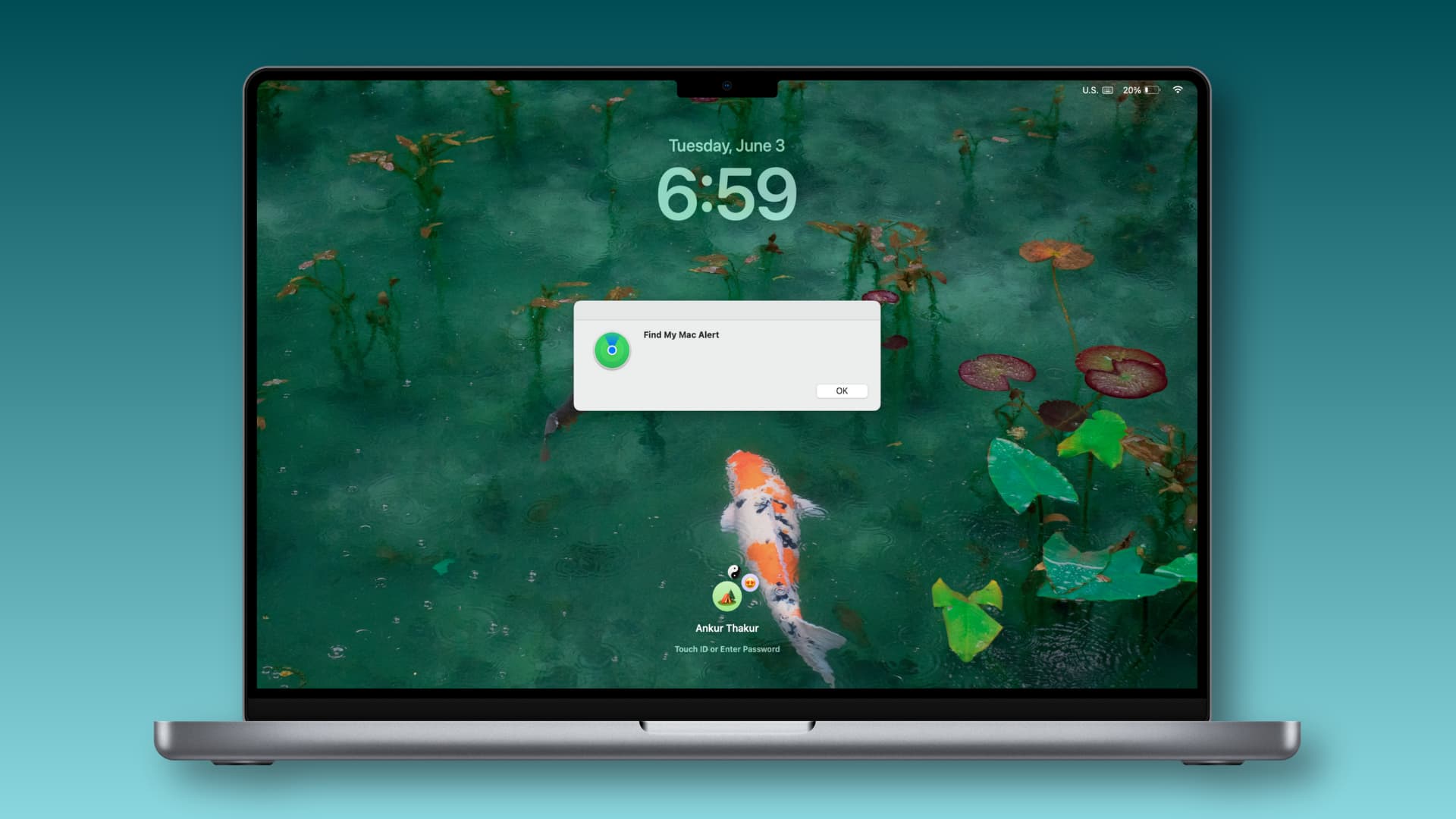How to find your lost or stolen MacBook or Mac desktop

Learn what to do if you lose your MacBook or a thief steals it, including viewing its location on a map, beeping it, displaying a custom message or wiping it remotely.
Of course, you’ll have much better chances to find a misplaced or lost Mac laptop because the built-in battery keeps it connected to the Find My network, which is crucial. Stolen desktop Macs are much tougher to find as they go offline when unplugged from power. You can, however use Find My features like Lost Mode but they won’t take effect until the device comes back online.
Your data is safely encrypted if you have a password
Apple silicon Macs and Intel-based Macs with Apple’s T2 Security chip encrypted files on the fly, as they’re written to and read from built-in storage, provided you’ve set up an admin password for your macOS user account, this is the same password you use to log in to your Mac or when Touch ID fails to work.
Intel-based Macs without the T2 chip can instead turn on FileVault in System Settings > Privacy & Security > FileVault to encrypt the entire startup disk and protect data on it even if the Mac is stolen or lost. Even if a thief somehow manages to erase your Mac, the Activation Lock feature will prevent them from setting it up.
Make a FaceTime call
Try calling your Mac. If it happens to be online, the person who found it may answer the call. Arrange a meeting to get back your computer.
If Find My is set up on the missing Mac
Open the Find My app on another iPhone, iPad, or Mac. You can also visit iCloud.com/find and log in with your Apple account. Then, select your missing Mac in the Devices section, and follow the steps below to find it. You can also use someone else’s Apple device for this job.
Note:
- Find My features like live location tracking, playing a sound, and remote lock or erase only work if your Mac is powered on and connected to the Internet.
- If you turned off “Wake for network access” in the battery settings, your Mac won’t update its location in Find My.
- If your Mac is switched off or offline, pending actions like remote locking or erasing the device will be carried out as soon as the computer goes online, which can happen if it re-connects to a known Wi-Fi network or a public hotspot.
See the location and get directions to your Mac
If your Mac’s current or last known location is available, look for it on the map and use the Directions button to navigate there.
Play a sound on your Mac
If your misplaced or stolen Mac is nearby, try alerting others with the Play Sound option. This will play a loud tone on your computer, even if it’s set to silent or DND mode.
Lock your Mac remotely and put it in Lost Mode
Putting your Mac in Lost Mode stops it from being erased by the person who found or stole it, disables Apple Pay and notification banners and displays a custom message on the Lock Screen. Tap Lost Mode for your Mac in the Find My app, then enter your custom message and hit Lock. Provide your mobile phone number or email in the custom message so that the person who finds your Mac can contact the rightful owner—you!
When your Mac is found, you can unlock it using your Apple account or macOS login password or. Otherwise, take the machine to your nearest Apple store along with proof of purchase (bill, receipt, etc) to have it unlocked. If you didn’t set up a login password on this Mac, you’ll be prompted to create one after turning on Lost Mode.
What if Find My is turned off?
If Find My is switched off, your Mac disconnect from the Find My network, meaning you cannot view its last known location, or beep, lock or erase it remotely. If Find My is turned off on your lost Mac or not working properly, follow these tips to secure your data.
- Change your Apple Account password on another device to prevent a thief from downloading your iCloud files, using iMessage and FaceTime, and more. Keep your old account password in a safe place because you may need it to unlock your Mac once found.
- Change passwords for your important online accounts like Gmail, Facebook, Instagram, etc.
- Go to the WhatsApp, Signal or Telegram settings on your iPhone and end the Mac session there.
If you still can’t locate your Mac
Find My isn’t perfect. You may see a “No location found” message or the app may display an older location. If you’ve tried everything but still cannot recover your Mac, try these tips.
Inform the police or local law enforcement about your missing Mac
You’ll need to provide the serial number of your Mac and other details so the police can take action to locate your Mac. Doing so also protects you from any liabilities if illegal activities are carried out on your stolen machine. Don’t forget to get a copy of the police report!
Inform your insurance company about an unfortunate event
If you have anti-theft protection with a third-party insurer, inform them about your missing Mac. You may need to provide a copy of the police report, so don’t skip the above tip!
The nuclear option
If Find My couldn’t help you recover your missing Mac, and every other solution provide futile, your last resort is the nuclear option—remote wipe!
Erase your Mac remotely using Find My
Use the Erase option in the Find My app or the iCloud website to remotely erase your computer. If the machine is powered off and offline, the request will be carried out the next time it comes online. Once the Mac is erased, you will no longer be able to track its location via Find My, play a sound, or activate Lost Mode.
Remove your Mac from your iCloud account
After remotely erasing a missing Mac, disassociate it from your Apple account.
Tips for the future
Follow these suggestions and preventative measures to prepare for the worse.
Check periodically to ensure Find My is on
Every few weeks or so, venture into System Settings > Apple Account > iCloud > See All > Find My Mac and check that both Find My Mac and Find My network are on.
Check location permission
Go to System Settings > Privacy & Security > Location Services and make sure the Location Services and Find My switches are both turned on, then click the Details button next to System Services and set Find My Mac to active.
Ensure Mac can wake up for network access
Find My works even with your MacBook’s lid closed so long as the computer is connected to the Internet and able to wake for network access. To check, go to System Settings > Battery > Options and select “Always” for “Wake for network access.”
Get insurance and learn more about it
AppleCare+ doesn’t offer theft protection for Macs, but third-party insurers do so check their offerings if you travel frequently or learn about these choices.
- Credit card insurance: Some credit cards offer 90-day or so insurance for purchases made with the card. If you’ve recently lost your new Mac, contact your credit card company for assistance.
- Renters insurance or house insurance: Check if these insurances cover lost computers.
- Car insurance: Some car insurers provide protection for any items that are stolen from the vehicle. If your MacBook was taken away from your car insured, check if this option is available to you.
- Airline insurance: When booking airplane tickets, you’re recommended to purchase optional insurance for your luggage. This will enable you to contact the airline or your insurance for help.
Back up your data regularly
Make it a habit to back up your photos, files, documents, and other essentials to cloud storage like iCloud, Google Drive, Dropbox, or OneDrive, or cloud solution such as BackBlaze. You can also back up your entire Mac to an external disk with Apple’s built-in Time Machine feature.
Keep an old Mac for backup
Instead of trading in or selling your old Mac, you can repurpose it for other tasks or keep it as a spare machine for emergencies when your main computer fails or is stolen.
Source link: https://www.idownloadblog.com/2025/06/06/how-to-find-your-missing-mac/



Leave a Reply